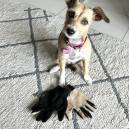How to prevent your dog from being stolen: Expert weighs in
September 05, 2011 • Health & Wellness • Most Popular
Have you seen the news lately? Dognapping is on the rise and the targets as well as the criminals are not those one might suspect.
The ugly trade of pet theft is a serious problem. It is an organized, multimillion dollar business that lurks in shadows and goes unnoticed until it strikes your community, your home, your pet. Protecting your dog takes due diligence, but loving guardians need to be armed with the latest in how to do that. FIDO Friendly asked Ines de Pablo, Executive Director of Pet Emergency Management Division - Wag'N Enterprises, for some input on the topic of dog theft, what it means, why it is on the rise, and what owners can do to keep Fido safe.
Why are pets stolen? Besides beint sold to research labs or pet stores, they are used in bait and for dog fighting rings, in puppy mills to breders, for fur (yes fur!), as breeding parnters for dogs, and by sadistic individuals.
Did you know there are two types of animal dealers in the U.S.? They are class A and class B.
Class A dealers maintain breeding colonies, whereas Class Bs obtain animals from “random sources.”
A Class B dealer license costs just $50, and with an insufficient number of inspectors and weak enforcement of existing regulations, the USDA has not made a priority of ensuring the safety and health of Class B dealer animals. As a result, many animals in the custody of Class B dealers are horribly mistreated and neglected.
Most random source animals are stolen from people’s backyards or while wandering around the neighborhood.
Laboratories prefer to work with domestic pets because they are more trusting and friendly toward people, and pets are popular with Class B dealers because it’s harder for their owners to trace them.
Ines offers these pet theft prevention tips:
1. Pets should WEAR TAGS at all times. Rabies and license/registration tags are required by law in most municipalities. A tattoo/microchip warning tag (if appropriate) warns finders that your pet is permanently identified (tattoos may be hard to see on longhaired pets, and microchips can’t be seen at all) and gives them a central registry phone number to call. Lost pets without tags – especially cats – often don’t get reclaimed.
2. TATTOO and/or MICROCHIP all pets for positive identification (it’s best to do both). Tattoo your social security number, drivers license number (be sure to include your state) or your purebred pet’s registration number (be sure to include registry initials: AKC, UKC, CFA, etc.) inside the thigh or on the belly (ears can be torn due to injury, or cut off).
3. REGISTER all tattoos or microchips with the appropriate registry. An unregistered tattoo or microchip is useless. The person who tattoos your pet or injects the microchip should give you information on how to register it.
4. CONFINE your pets. The safest place for them when you’re not home is INDOORS. This includes cats, too!
5. PADLOCK GATES. If you must leave your dog outside in a fenced yard, at least make it difficult for others to get to him. Padlocks and chains should be placed high, so the ground can’t be used as leverage for bolt cutters.
6. Fit an alarm/bell to your gate so that you can hear visitors/trespassers enter your property.
7. Dogs that are kept tied in unfenced yards should be located OUT OF VIEW of passersby. The fence needs to be at least 6 feet high and padlocked.
8. NEVER let your dog off his chain or leash – even for a minute – if you won’t be right there to watch him the whole time! In most places it’s illegal, and it’s an open invitation for trouble!
9. Train your dog not to go out of your sight on walks. Use an extending lead if the dog does not comply. Vary your walk times and routes.
10. Don’t leave your dog tied in public places while you go in stores to shop! In VA it happens to be illegal. If the dog must go shopping with make sure you only go to stores that allow the dog to enter. Otherwise leave the dog at home.
11. If you have a doggy door. Lock it when you are not home! Let the dog do its business before you leave, let him in, lock door. Keeps it safe from snakes, wasps and bees and thieves.
12. SPAY or NEUTER all pets. This makes them less inclined to wander, and eliminates any resale value for breeding purposes.
13. If a stranger approaches you about buying or breeding to your pet, tell him the pet has been spayed or neutered, even if it hasn’t. WRITE DOWN the person’s name, address, and license plate number, and keep a close eye on your pet afterwards!
14. DO NOT put your pet’s name on his ID tag or display it on his dog house. A pet is much more likely to go to (and with) a stranger who calls him by name.
15. DO NOT talk to strangers about the value, bloodlines, training or special abilities of your pet.
16. Do Not put your pet's name on his ID tag or display it on his dog house. A pet is much more likely to go to (and with) a stranger who calls him by name.
17. If your pet loses its tags, get replacements right away! Remember, in order for the tags to protect your pet, your pet must be wearing the tags!
18. Slip collars (aka choke chains) are for training or walking only; pets should wear flat or rolled buckle collars for everyday use, and tags should be attached to the buckle collar.
19. On the Road: Never leave your dog in an unattended car, even if it’s locked – Besides the obvious health risks this poses to the dog, it’s also an invitation for thieves, even if you are gone for only a moment. Leaving expensive items in the car such as a GPS unit or laptop will only encourage break-ins and possibly allow the dog to escape, even if the thieves don’t decide to steal it too.
20. During hurricane Katrina, a lot of dogs were stolen from shelters. In terms of disaster preparedness we recommend owners keep pictures of them with their pets (entire family) in multiple angles. This makes it easier to prove that dog is yours when you seek to reclaim a pet and if left at shelter it will be part of the shelter paperwork to prevent the release to unauthorized party.
21. We also recommend having pre-printed lost pet poster copies in your car and in your emergency Go-Bag as access to photocopy machines and paper may be hindered during an emergency.
22. Make sure to include your pets in your emergency preparedness plan. DO NOT LEAVE PETS BEHIND when you evacuate. Its asking for loss and/or theft.
23. DON’T BUY STOLEN PETS. Don’t buy dogs from the internet, flea markets, or roadside vans There is simply no way to verify where an animal purchased from any of these outlets came from. Web sites and online classifieds are easily falsified, and with roadside or flea market purchases not only do you not know the pet’s origins but you will never be able to find or identify the seller in case of a problem. Even newspaper ads may be suspect. Adult dogs offered for sale at reduced prices, for a “relocation” fee, or accompanied by requests for last minute shipping fees are red flags. Dog owners who truly love their animals and are unable to keep them will opt to find a loving home without compensation for re-homing the animal. Seek out reputable breeders or rescue groups. Visit the home of the breeder, meet the puppy’s mother, and see the litter of puppies. Developing a good relationship with the breeder will bring you peace of mind when purchasing. Contacting breed rescue groups can also be a safe alternative if you are looking for an adult dog. But either way ALWAYS Demand proper papers on your purebred puppy. Ask for the AKC Litter Registration Number and contact AKC customer service at 919-233-9767 to verify registration authenticity of your purebred puppy.
What to do in an emergency if your pet is stolen? Tips to follow in part two of this very important series.
Join the FIDO Friendly pack and never a single issue of the one magazine your dog will thank you for.







